 Notes:Although Brockholes station did not immediately appear in timetables, it opened with the Huddersfield- Penistone line on 1 July 1850. It was the junction for the Holmfirth Branch which opened the same day. Brockholes had two platforms. The principal buildings were on the up (north-east) platform and it is assumed that at least the section containing the stationmaster’s house was provided from the opening. This structure, built of small, coursed blocks of sandstone, was of two storeys, but only a single storey was presented to the platform beneath a tall, steeply pitched roof whilst the two-storey section extended away from the platform. A canted bay abutted the platform. A single-storey office range stretched south-east of the other building. It also possessed a canted bay, and the pitched roof was lower and at a gentler gradient than its neighbour. Further south-east, at the platform ramp was a water tower on a stone plinth with the water crane in attendance. Finally, just before the road underbridge was a goods office, also stone-built. On the opposite platform, somewhat further north-west than the buildings on the up platform was a substantial waiting block in sandstone, its hipped roof extending towards the tracks and supported on a series of chunky wooden brackets to provide shelter. An iron lattice footbridge, added circa 1900, connected the platforms. Notes:Although Brockholes station did not immediately appear in timetables, it opened with the Huddersfield- Penistone line on 1 July 1850. It was the junction for the Holmfirth Branch which opened the same day. Brockholes had two platforms. The principal buildings were on the up (north-east) platform and it is assumed that at least the section containing the stationmaster’s house was provided from the opening. This structure, built of small, coursed blocks of sandstone, was of two storeys, but only a single storey was presented to the platform beneath a tall, steeply pitched roof whilst the two-storey section extended away from the platform. A canted bay abutted the platform. A single-storey office range stretched south-east of the other building. It also possessed a canted bay, and the pitched roof was lower and at a gentler gradient than its neighbour. Further south-east, at the platform ramp was a water tower on a stone plinth with the water crane in attendance. Finally, just before the road underbridge was a goods office, also stone-built. On the opposite platform, somewhat further north-west than the buildings on the up platform was a substantial waiting block in sandstone, its hipped roof extending towards the tracks and supported on a series of chunky wooden brackets to provide shelter. An iron lattice footbridge, added circa 1900, connected the platforms.
It is not known whether the station was lit by gas from the start, but by the late nineteenth century this form of lighting was used, with casement lanterns mounted on iron posts.
The station was called ‘Brockholes Junction’ in timetables from at least 1851 until 1878. The form ‘Brock Holes’ has also been seen, for example on Ordnance Survey maps.
Northbound trains: weekdays Feb 1863 |
Destination |
Southbound trains: weekdays |
Destination |
7.41am |
Huddersfield |
7.07am |
Penistone |
8.23am |
Huddersfield |
7.20pm |
Holmfirth |
8.56am |
Huddersfield |
8.40am |
Holmfirth |
11.06am |
Huddersfield |
10.05am |
Penistone |
11.20am |
Huddersfield |
10.47am |
Holmfirth |
1.16pm |
Huddersfield |
12.08pm |
Penistone |
2.55pm |
Huddersfield |
12.33pm |
Holmfirth |
3.17pm |
Huddersfield |
2.47pm |
Holmfirth |
5.05pm |
Huddersfield |
4.45pm |
Holmfirth |
7.43pm |
Huddersfield |
5.09pm |
Penistone |
7.51pm |
Huddersfield |
7.32pm |
Holmfirth |
9.50pm |
Huddersfield |
- |
- |
Northbound trains: Sunday |
Destination |
Southbound trains: Sunday |
Destination |
7.03am |
Huddersfield |
6.44am |
Holmfirth |
9.07am |
Huddersfield |
7.46am |
Penistone |
11.17am |
Huddersfield |
10.30am |
Holmfirth |
7.46pm |
Huddersfield |
5.15pm |
Sheffield |
8.16pm |
Huddersfield |
7.47pm |
Holmfirth |
9.50pm |
Huddersfield |
8.45pm |
Penistone |
Note: Northbound trains from Holmfirth Branch are in bold type.
Goods facilities at Brockholes were not extensive, with a 2 ton 10 cwt-capacity yard crane, and a loop with headshunts behind the down platform, extending beyond the bridge over Brock Holes Lane. The RCH Handbook of 1904 notes that livestock and horse-boxes were handled, as was coal, which was standard at all staffed stations.
Northbound trains: weekdays Dec 1895 |
Destination |
Southbound trains: weekdays |
Destination |
5.52am |
Bradford ¶ |
5.26am |
Holmfirth |
6.52am |
Bradford ¶ |
6.20am |
Holmfirth |
7.44am |
Bradford § |
6.42am |
Shepley & Shelley |
8.02am |
Bradford ¶ |
6.54am |
Penistone |
8.33am |
Bradford ¶ |
7.22am |
Holmfirth |
8.40am |
Bradford ¶ |
8.07am |
Holmfirth |
9.30am |
Huddersfield |
8.11am |
Penistone |
9.37am |
Bradford ‡ |
8.18am |
Clayton West |
9.50am |
Bradford ¶ |
9.12am |
Holmfirth |
11.07am |
Halifax |
10.06am |
London Kings Cross |
11.37am |
Bradford ‡ |
10.08am |
Clayton West |
12.44am |
Bradford ¶ |
10.44am |
Holmfirth |
1.29pm |
Huddersfield |
11.54am |
Penistone |
1.52pm |
Bradford ‡ |
12.22pm |
Holmfirth |
2.11pm |
Bradford ¶ |
12.27pm |
Clayton West |
2.42pm |
Bradford ¶ |
12.37pm |
Penistone |
3.12pm |
Bradford ¶ |
1.42pm |
Holmfirth |
3.31pm |
Bradford ¶ |
2.10pm |
London Kings Cross |
4.57pm |
Bradford ¶ |
2.37pm |
Clayton West |
5.17pm |
Bradford ¶ |
2.42pm |
Holmfirth |
5.27pm |
Low Moor |
3.17pm |
Penistone |
5.55pm # |
Bradford ¶ |
4.17pm |
Clayton West |
6.10pm |
Bradford ¶ |
4.34pm |
Holmfirth |
6.36pm |
Bradford ‡ |
5.00pm |
Penistone |
7.07pm |
Bradford ¶ |
5.29pm |
Clayton West |
8.02pm |
Halifax |
5.42pm |
Holmfirth |
8.21pm |
Huddersfield |
6.29pm |
Holmfirth |
8.32pm |
Bradford ¶ |
6.34pm |
Shepley & Shelley |
9.30pm # |
Bradford ¶ |
7.21pm |
Holmfirth |
9.34pm |
Bradford ¶ |
8.52pm (Sat only) |
Clayton West |
9.42pm (Sat only) |
Huddersfield |
9.02pm |
Holmfirth |
10.02pm (Sat only) |
Huddersfield |
9.17pm (Sat only) |
Holmfirth |
11.02pm |
Bradford ¶ |
9.42pm |
Penistone |
11.07pm |
Bradford ¶ |
10.42pm |
Holmfirth |
- |
- |
11.12pm (Sat only) |
Holmfirth |
Northbound trains: weekdays |
Destination |
Southbound trains: weekdays Dec 1895 |
Destination |
8.49am |
Bradford ¶ |
7.52am |
Penistone |
9.17am |
Bradford ¶ |
8.52am |
Holmfirth |
11.04am |
Bradford ¶ |
10.40am |
Holmfirth |
5.12pm |
Bradford ¶ |
3.07pm |
Holmfirth |
7.27pm |
Huddersfield |
5.17pm |
Penistone |
8.22pm |
Bradford ¶ |
7.52pm |
Holmfirth |
9.52pm |
Bradford ¶ |
8.44pm |
Penistone |
KEY: ¶ via Halifax § via Clifton Road ‡ via Mirfield
# Approximate time of request stop for through train from London Kings Cross for passengers to alight.
Northbound trains from Holmfirth Branch are in bold type.

The timetable, below, was current for the year in which the Lancashire & Yorkshire Railway (LYR) was absorbed into the London & North Western (LNWR), prior to the Grouping of 1923 when Brockholes became part of the London, Midland & Scottish Railway (LMS).
Northbound trains: weekdays July 1922 |
Destination |
Southbound trains: weekdays |
Destination |
5.41am |
Huddersfield |
5.52am |
Holmfirth |
6.29am |
Huddersfield |
6.19am |
Holmfirth |
6.50am |
Huddersfield |
6.30am (starts here) |
Clayton West |
7.21am |
Huddersfield |
6.43am |
Penistone |
7.45am |
Huddersfield |
6.58am |
Holmfirth |
8.25am |
Huddersfield |
8.00am |
Holmfirth |
8.32am |
Huddersfield |
8.10am (starts here) |
Clayton West |
9.35am |
Huddersfield |
8.34am |
London Marylebone |
9.57am |
Huddersfield |
9.10am |
Holmfirth |
10.49am |
Huddersfield |
9.46am |
Penistone |
11.29am (Sat excepted) |
Huddersfield |
10.27am |
Holmfirth |
12.20pm (Sat only) |
Huddersfield |
10.32am (starts here) |
Clayton West |
12.56pm |
Huddersfield |
10.45am † |
London Marylebone |
1.29pm |
Huddersfield |
12.24pm |
Holmfirth |
1.45pm |
Huddersfield |
12.29pm |
Penistone |
2.01pm |
Huddersfield |
12.38pm |
Clayton West |
2.30pm |
Huddersfield |
1.39pm |
Holmfirth |
3.11pm |
Huddersfield |
2.29pm |
Penistone |
3.29pm |
Huddersfield |
2.42pm |
Clayton West |
4.48pm |
Huddersfield |
2.47pm |
Holmfirth |
5.08pm |
Huddersfield |
4.25pm |
Holmfirth |
5.19pm |
Huddersfield |
4.33pm |
Clayton West |
6.02pm |
Huddersfield |
5.14pm |
Penistone |
6.47pm |
Huddersfield |
5.30pm |
Holmfirth |
7.06pm |
Huddersfield |
5.40pm † |
London Marylebone |
7.20pm $ |
Bradford |
5.50pm |
Clayton West |
7.51pm |
Huddersfield |
6.09pm (Sat excepted) |
Holmfirth |
8.03pm |
Huddersfield |
6.17pm |
Penistone |
8.39pm |
Huddersfield |
6.42pm (Sat only) |
Holmfirth |
8.56pm |
Huddersfield |
6.57pm |
Clayton West |
9.20pm |
Huddersfield |
7.34pm |
Penistone |
9.26pm (Sat only) |
Huddersfield |
7.40pm |
Holmfirth |
10.06pm |
Huddersfield |
8.28pm |
Holmfirth |
10.15pm $ |
Bradford |
9.03pm (Sat only) |
Holmfirth |
10.26pm |
Huddersfield |
9.21pm |
Clayton West |
11.11pm |
Huddersfield |
9.38pm |
Holmfirth |
- |
- |
10.10pm |
Penistone |
- |
- |
10.41pm (Sat only) |
Clayton West |
- |
- |
10.50pm |
Holmfirth |
Northbound trains: Sunday |
Destination |
Southbound trains: Sunday |
Destination |
8.52am |
Huddersfield |
7.55am |
Penistone |
9.06am |
Huddersfield |
10.40am |
Holmfirth |
11.16am |
Huddersfield |
5.10pm |
Penistone |
7.45pm |
Huddersfield |
7.50pm |
Holmfirth |
8.26pm |
Huddersfield |
9.00pm |
Penistone |
10.10pm |
Huddersfield |
10.31pm |
Holmfirth |
$ Approximate calling time for passengers to alight by request.
† Approximate calling time for passengers to join by request.
Northbound trains from Holmfirth Branch are in bold type.
 The LMS imposed its identity on this station and its neighbours on the Huddersfield-Penistone line by installing ‘Hawkseye’ nameboards – the trademark of the manufacturer G C Hawkes of Birmingham. Embossed black letters were used on a yellow background. The LYR signage for the rooms and footbridge were retained. Biddle (1973) points out that at Brockholes odd emphasis on a sign was given by enlarging certain letters: unexpectedly large letters proclaimed ‘TO TRAINS FOR’, followed in much smaller letters (and distinguishable only from a much shorter distance) by the apparently single sentence: ‘Huddersfield Passengers Must Not Cross the Line’. Either in later LMS years or early in the British Railways (BR) era the casement gas lanterns were replaced with ones of ‘Sugg’ design. The LMS imposed its identity on this station and its neighbours on the Huddersfield-Penistone line by installing ‘Hawkseye’ nameboards – the trademark of the manufacturer G C Hawkes of Birmingham. Embossed black letters were used on a yellow background. The LYR signage for the rooms and footbridge were retained. Biddle (1973) points out that at Brockholes odd emphasis on a sign was given by enlarging certain letters: unexpectedly large letters proclaimed ‘TO TRAINS FOR’, followed in much smaller letters (and distinguishable only from a much shorter distance) by the apparently single sentence: ‘Huddersfield Passengers Must Not Cross the Line’. Either in later LMS years or early in the British Railways (BR) era the casement gas lanterns were replaced with ones of ‘Sugg’ design.
At Nationalisation on 1 January 1948 the LMS lines in England & Wales were allocated to the new London Midland Region of BR. Boundary changes followed for operating and administrative convenience, and on 2 April 1950 the line north of Penistone was transferred to the North Eastern Region.
Northbound trains: weekdays Sep 1950 |
Destination |
Southbound trains: weekdays |
Destination |
6.34am |
Huddersfield |
6.31am |
Clayton West |
6.43am |
Low Moor |
6.43am |
Penistone |
7.18am (Sat excepted) |
Halifax |
6.57am (Sat excepted) |
Holmfirth |
7.44am |
Bradford ‡ |
7.59am |
Holmfirth |
8.20am |
Huddersfield |
8.34am |
Penistone |
8.33am |
Huddersfield |
9.34am |
Penistone |
10.00am |
Huddersfield |
10.50am † |
London Marylebone |
10.38am |
Bradford ‡ |
12.29pm |
Penistone |
12.20pm (Sat only) |
Huddersfield |
12.38pm (Sat only) |
Clayton West |
1.29pm |
Huddersfield |
12.56pm |
Holmfirth |
1.39pm |
Huddersfield |
4.00pm |
Penistone |
1.47pm |
Bradford ‡ |
4.24pm (Sat excepted) |
Holmfirth |
3.20pm |
Mirfield |
4.35pm |
Clayton West |
4.59pm (Sat only) |
Leeds City |
5.15pm |
Penistone |
5.06pm (Sat excepted) |
Bradford ‡ |
5.36pm |
Holmfirth |
5.21pm |
Huddersfield |
5.50pm |
Clayton West |
5.35pm |
Bradford ¶ |
6.19pm (Sat excepted) |
Holmfirth |
6.30pm |
Huddersfield |
6.25pm |
Penistone |
6.56pm |
Mirfield |
6.57pm |
Clayton West |
7.53pm |
Huddersfield |
7.33pm |
Penistone |
9.07pm |
Huddersfield |
9.33pm |
Clayton West |
9.45pm |
Bradford ¶ |
10.20pm |
Penistone |
10.34pm |
Huddersfield |
1055pm (Sat only) |
Clayton West |
Northbound trains: Sunday |
Destination |
Southbound trains: Sunday |
Destination |
11.10am |
Huddersfield |
10.14am |
Penistone |
6.03pm |
Huddersfield |
5.06pm |
Penistone |
10.10pm |
Bradford ¶ |
9.05pm |
Penistone |
KEY: ¶ via Halifax ‡ via Mirfield † Approximate calling time for passengers to join by request.
Northbound trains from Holmfirth Branch are in bold type.
Brockholes ceased to be a passenger junction station in 1959 when the Holmfirth Branch closed. Sunday trains had run on the Huddersfield-Penistone line only in summer from c1956. Little investment was made in Brockholes station by the North Eastern Region, although a coat of dull orange paint was applied to the signs. With the threat of closure hanging over the station from March 1963 (‘Beeching Report’) LMS and LYR signage were considered adequate. On 14 April 1966 the Minister of Transport refused to permit the line to close and, four months later, on 15 August Brockholes and the other intermediate stations between Huddersfield and Penistone became unstaffed and thereafter tickets were issued by the conductor / guard on the train.
Northbound trains: weekdays June 1964 |
Destination |
Southbound trains: weekdays |
Destination |
6.42am (Sat excepted) |
Bradford ¶ |
6.43am |
Penistone |
7.11am |
Bradford ‡ |
7.28am |
Clayton West |
7.41am |
Bradford ‡ |
7.53am |
Penistone |
8.16am |
Bradford ‡ |
8.30am |
Penistone |
8.36am |
Bradford ¶ |
9.30am |
Penistone |
9.46am |
Bradford ¶ |
10.53am |
Penistone |
10.23am |
Bradford ‡ |
11.53am |
Penistone |
11.36am |
Bradford ¶ |
12.24pm |
Clayton West |
12.36pm (Sat only) |
Huddersfield |
12.53pm |
Penistone |
1.18pm (Sat only) |
Bradford ‡ |
1.27pm (Sat only) |
Penistone |
1.31pm (Sat excepted) |
Huddersfield |
4.13pm |
Penistone |
1.43pm |
Huddersfield |
4.33pm |
Clayton West |
2.28pm (Sat only) |
Huddersfield |
5.15pm |
Penistone |
3.23pm (Sat excepted) |
Huddersfield |
(5.33pm |
Terminates here) |
3.23pm (Sat only) |
Bradford ‡ |
5.55pm |
Clayton West |
5.29pm |
Wakefield Westgate |
6.13pm |
Penistone |
6.23pm |
Bradford ‡ |
7.28pm |
Penistone |
7.03pm |
Bradford ‡ |
9.13pm |
Penistone |
7.27pm |
Bradford ¶ |
10.43pm (Fri excepted) |
Penistone |
8.23pm |
Bradford ‡ |
10.48pm (Fri only) |
Penistone |
10.23pm (Sat excepted) |
Huddersfield |
11.08pm (Sat only) |
Clayton West |
10.23pm (Sat only) |
Bradford ‡ |
- |
- |
Northbound trains: Sunday |
Destination |
Southbound trains: Sunday |
Destination |
12.15pm |
Bradford ¶ |
11.04am |
Penistone |
3.20pm |
Bradford ¶ |
2.38pm |
Penistone |
5.25pm |
Huddersfield |
4.44pm |
Penistone |
9.40pm |
Bradford ¶ |
8.43pm |
Penistone |
KEY: ¶ via Halifax ‡ via Mirfield
Sunday trains were withdrawn after the summer season of 1967, by which time Brockholes was in BR Eastern Region; the NE Region had been absorbed by the Eastern in January 1967.
 It was some years after the closure threat was removed that in the early 1970s the old signage at Brockholes station was replaced with black-and-white ‘Corporate Identity’ signs. Gas lighting survived a little longer. Electric lighting, carried on the massive lamp posts beloved of the Eastern Region, had appeared by 1978. It was some years after the closure threat was removed that in the early 1970s the old signage at Brockholes station was replaced with black-and-white ‘Corporate Identity’ signs. Gas lighting survived a little longer. Electric lighting, carried on the massive lamp posts beloved of the Eastern Region, had appeared by 1978.
The waiting room on the down platform and the water tank were removed circa 1970, but the main buildings and goods office were retained. The privately-occupied stationmaster’s house received a crudely-designed dormer on the platform elevation sometime between 1978 and 1984.
Northbound trains: weekdays May 1982 |
Destination |
Southbound trains: weekdays |
Destination |
06.42 (Sat excepted) |
Huddersfield |
06.21 (Sat only) |
Penistone |
07.04 |
Huddersfield |
06.51 (Sat excepted) |
Penistone |
07.32 (Sat excepted) |
Huddersfield |
07.18 |
Clayton West |
08.10 |
Huddersfield |
07.36 |
Sheffield |
08.31 |
Huddersfield |
09.09 |
Sheffield |
09.55 |
Huddersfield |
10.45 |
Sheffield |
12.18 |
Huddersfield |
12.21 |
Clayton West |
13.08 |
Huddersfield |
13.13 |
Sheffield |
14.06 |
Huddersfield |
16.13 |
Clayton West |
16.27 |
Leeds |
16.31 |
Sheffield |
16.53 |
Huddersfield |
17.29 |
Sheffield |
17.43 |
Huddersfield |
17.48 |
Clayton West |
18.21 |
Huddersfield |
18.11 |
Sheffield |
18.48 |
Huddersfield |
- |
- |
20.20 |
Huddersfield |
- |
- |
No Sunday trains |
- |
No Sunday trains |
- |
As noted in the line history, in the 1980s the future of the Huddersfield-Penistone service was looking uncertain, and in 1983 the Clayton West Branch closed to passengers. Eventually in 1987 arrangements were made to retain the service through to Sheffield (via Barnsley) and the train services were improved. In summer 1988 an approximately hourly interval weekday service was introduced and Sunday trains (all year) were restored. However the tracks from Huddersfield to a point just short of Stocksmoor were singled in April 1989, leaving Brockholes with only the former down platform in use. Part of this platform was raised to standard height.
The stationmaster’s house and office range on the redundant up platform are now extremely attractive. The 1970s dormer with its flat roof has given way to a gabled dormer which looks entirely in keeping. Various ‘heritage’ signs have been added, and window glass proclaims the LYR background while a poster-board – complete with attractive posters – is headed ‘London, Midland & Scottish Railway’. A LMR-style totem is fixed to a trackside building just north-west of the bi-directional platform. The short-lived BR(NER) era seems not to be commemorated!
Route map drawn by Alan Young. Tickets from Michael Stewart. Bradshaw from Alan Young,
Click here for a brief history of the Holmfirth branch.
To see other stations on the Holmfirth branch
click on the station name:
Holmfirth & Thongs Bridge |

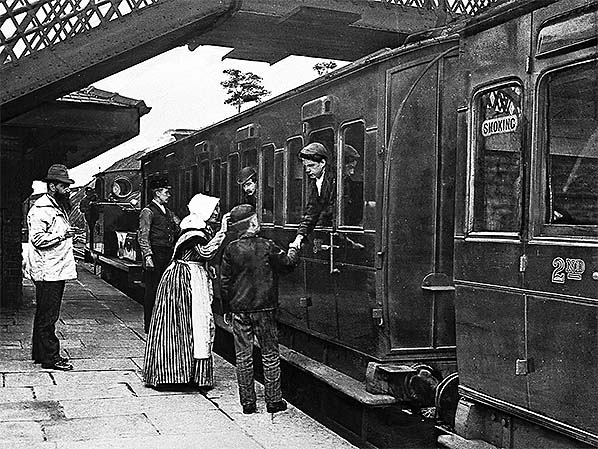

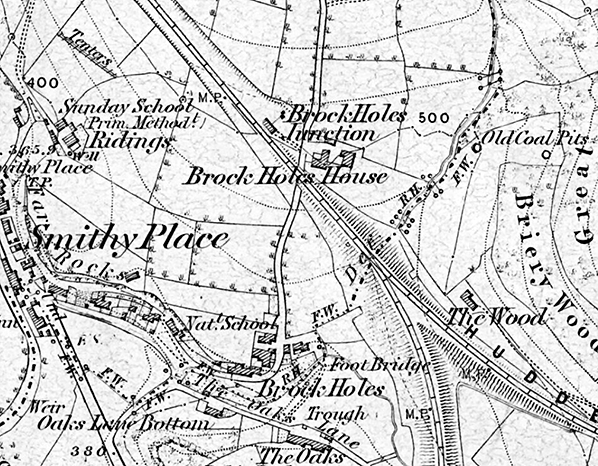
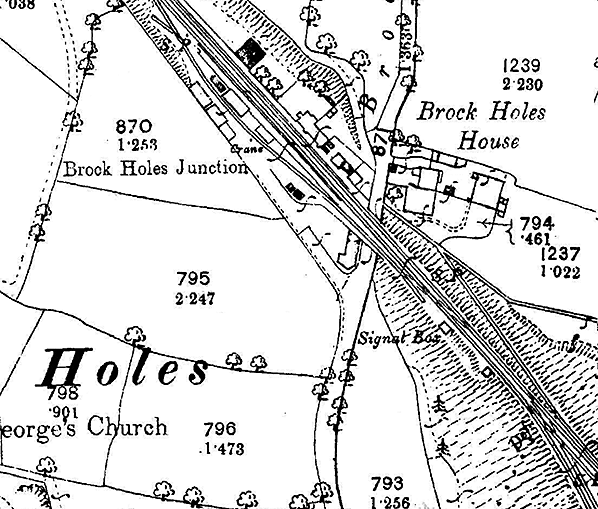
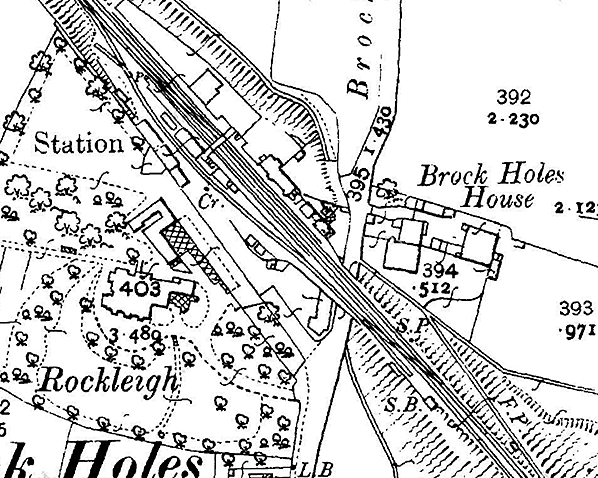
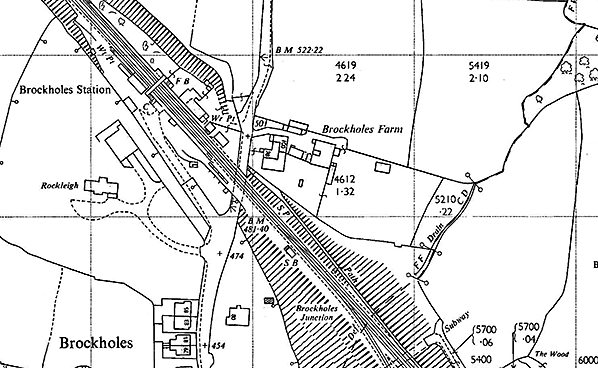
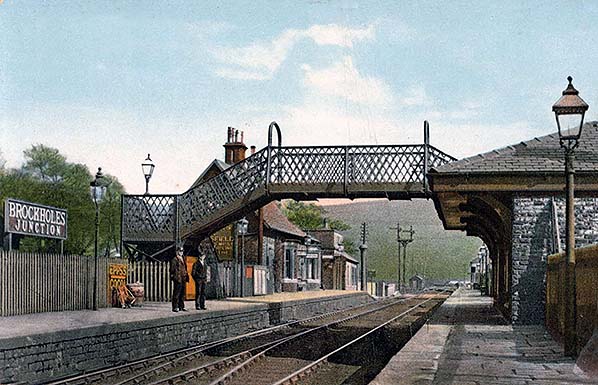
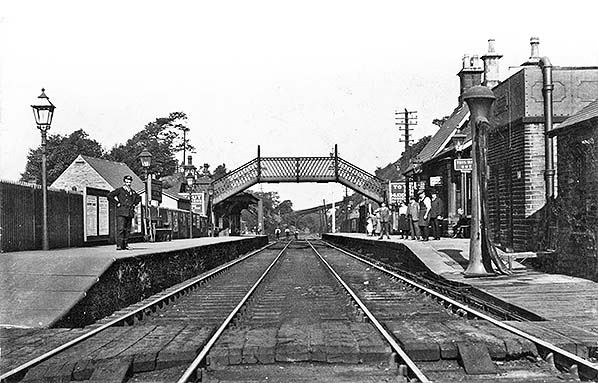
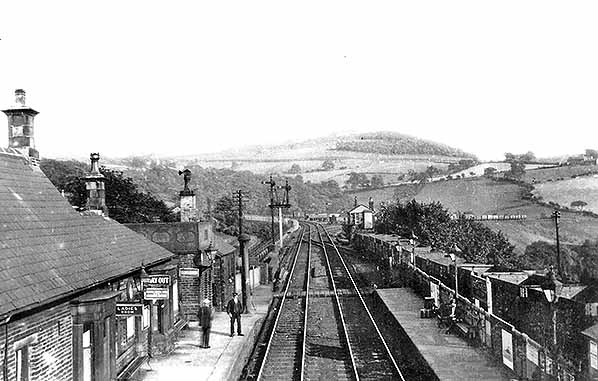
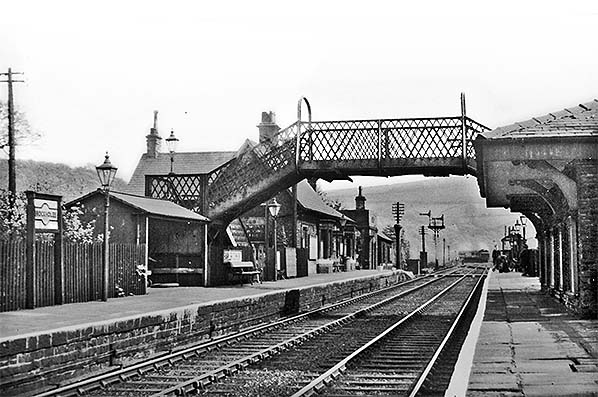
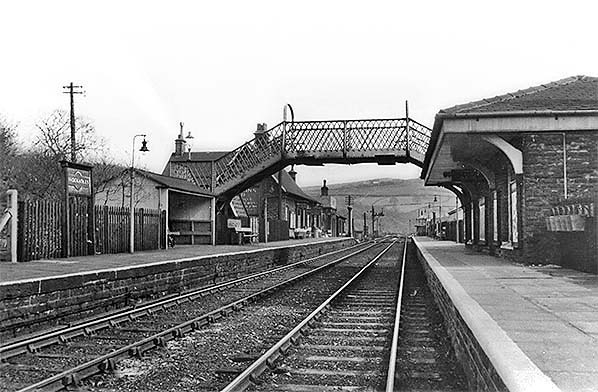
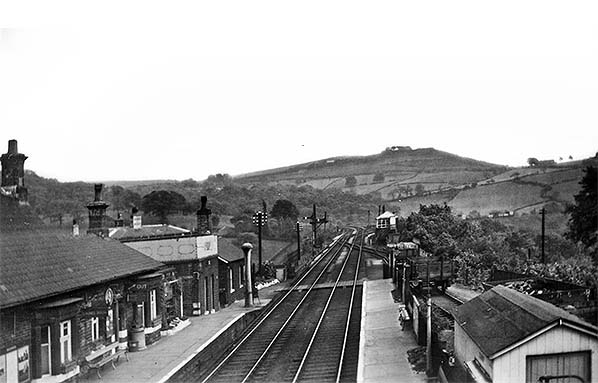
 Notes:Although Brockholes station did not immediately appear in timetables, it opened with the Huddersfield- Penistone line on 1 July 1850. It was the junction for the Holmfirth Branch which opened the same day. Brockholes had two platforms. The principal buildings were on the up (north-east) platform and it is assumed that at least the section containing the stationmaster’s house was provided from the opening. This structure, built of small, coursed blocks of sandstone, was of two storeys, but only a single storey was presented to the platform beneath a tall, steeply pitched roof whilst the two-storey section extended away from the platform. A canted bay abutted the platform. A single-storey office range stretched south-east of the other building. It also possessed a canted bay, and the pitched roof was lower and at a gentler gradient than its neighbour. Further south-east, at the platform ramp was a water tower on a stone plinth with the water crane in attendance. Finally, just before the road underbridge was a goods office, also stone-built. On the opposite platform, somewhat further north-west than the buildings on the up platform was a substantial waiting block in sandstone, its hipped roof extending towards the tracks and supported on a series of chunky wooden brackets to provide shelter. An iron lattice footbridge, added circa 1900, connected the platforms.
Notes:Although Brockholes station did not immediately appear in timetables, it opened with the Huddersfield- Penistone line on 1 July 1850. It was the junction for the Holmfirth Branch which opened the same day. Brockholes had two platforms. The principal buildings were on the up (north-east) platform and it is assumed that at least the section containing the stationmaster’s house was provided from the opening. This structure, built of small, coursed blocks of sandstone, was of two storeys, but only a single storey was presented to the platform beneath a tall, steeply pitched roof whilst the two-storey section extended away from the platform. A canted bay abutted the platform. A single-storey office range stretched south-east of the other building. It also possessed a canted bay, and the pitched roof was lower and at a gentler gradient than its neighbour. Further south-east, at the platform ramp was a water tower on a stone plinth with the water crane in attendance. Finally, just before the road underbridge was a goods office, also stone-built. On the opposite platform, somewhat further north-west than the buildings on the up platform was a substantial waiting block in sandstone, its hipped roof extending towards the tracks and supported on a series of chunky wooden brackets to provide shelter. An iron lattice footbridge, added circa 1900, connected the platforms.
 The LMS imposed its identity on this station and its neighbours on the Huddersfield-Penistone line by installing ‘Hawkseye’ nameboards – the trademark of the manufacturer G C Hawkes of Birmingham. Embossed black letters were used on a yellow background. The LYR signage for the rooms and footbridge were retained. Biddle (1973) points out that at Brockholes odd emphasis on a sign was given by enlarging certain letters: unexpectedly large letters proclaimed ‘TO TRAINS FOR’, followed in much smaller letters (and distinguishable only from a much shorter distance) by the apparently single sentence: ‘Huddersfield Passengers Must Not Cross the Line’. Either in later LMS years or early in the British Railways (BR) era the casement gas lanterns were replaced with ones of ‘Sugg’ design.
The LMS imposed its identity on this station and its neighbours on the Huddersfield-Penistone line by installing ‘Hawkseye’ nameboards – the trademark of the manufacturer G C Hawkes of Birmingham. Embossed black letters were used on a yellow background. The LYR signage for the rooms and footbridge were retained. Biddle (1973) points out that at Brockholes odd emphasis on a sign was given by enlarging certain letters: unexpectedly large letters proclaimed ‘TO TRAINS FOR’, followed in much smaller letters (and distinguishable only from a much shorter distance) by the apparently single sentence: ‘Huddersfield Passengers Must Not Cross the Line’. Either in later LMS years or early in the British Railways (BR) era the casement gas lanterns were replaced with ones of ‘Sugg’ design. It was some years after the closure threat was removed that in the early 1970s the old signage at Brockholes station was replaced with black-and-white ‘Corporate Identity’ signs. Gas lighting survived a little longer. Electric lighting, carried on the massive lamp posts beloved of the Eastern Region, had appeared by 1978.
It was some years after the closure threat was removed that in the early 1970s the old signage at Brockholes station was replaced with black-and-white ‘Corporate Identity’ signs. Gas lighting survived a little longer. Electric lighting, carried on the massive lamp posts beloved of the Eastern Region, had appeared by 1978.
 Home Page
Home Page